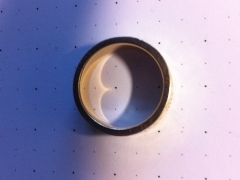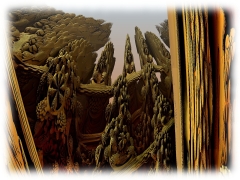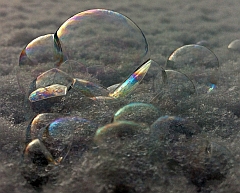 Time and again, there are moments when mathematics just feels magical.
Time and again, there are moments when mathematics just feels magical.
For me, one example for this is given by generating functions (and that is why they can be found on this blog).
Today, I want to talk about another such example: involutions. We will look at how they are used to prove in one sentence that primes of the form can be written as a sum of squares, in the proof of the wonderful Lindström-Gessel-Viennot lemma, and in the proof of Euler’s pentagonal number theorem.
Glimpses
The Beats of Bitterns
 In my PhD thesis and in the paper Detecting bird sounds in a complex acoustic environment and application to bioacoustic monitoring, I have proposed a simple yet robust algorithm for automatically detecting calls of the Eurasian bittern in the wild.
In my PhD thesis and in the paper Detecting bird sounds in a complex acoustic environment and application to bioacoustic monitoring, I have proposed a simple yet robust algorithm for automatically detecting calls of the Eurasian bittern in the wild.
The Eurasian bittern is a threatened bird species found in reed beds and other wetland habitats. Its sound is very simple, very deep, and very characteristic. It is pretty similar to what you can produce by blowing over the opening of an empty bottle (use a large one) in regular intervals.
Recently, I have been asked whether I still have the Matlab code for the algorithm. A bit of digging on an external hard drive has shown that I indeed still have it.
How Algebra Sheds Light on Things
 Egbert Brieskorn‘s mathematics books contain a lot more flesh than those structured strictly by definitions, lemmas, and theorems. What might be a hindrance to those looking for a quick grasp of a theory is a treasure trove for others who relish an extra of motivation, history, and examples. Currently, I am reading his book Plane Algebraic Curves (authored together with Horst Knörrer) which, already in the introductory chapter, contains many wonderful examples such as linkages, envelopes, and the Hopf fibration. I will come back to some of these topics in later posts. Today’s post contains a quick glimpse of caustics.
Egbert Brieskorn‘s mathematics books contain a lot more flesh than those structured strictly by definitions, lemmas, and theorems. What might be a hindrance to those looking for a quick grasp of a theory is a treasure trove for others who relish an extra of motivation, history, and examples. Currently, I am reading his book Plane Algebraic Curves (authored together with Horst Knörrer) which, already in the introductory chapter, contains many wonderful examples such as linkages, envelopes, and the Hopf fibration. I will come back to some of these topics in later posts. Today’s post contains a quick glimpse of caustics.
The Mandelbulb
 It seems completely natural that going from 2d to 3d adds a new dimension of awesomeness to fractals. Accordingly, it is quite a shame that until very recently, I was not aware of the magnificent Mandelbulb. If this is a new world for you, too, go and explore the wonders of 3d fractals using tools like Mandelbulb 3d.
It seems completely natural that going from 2d to 3d adds a new dimension of awesomeness to fractals. Accordingly, it is quite a shame that until very recently, I was not aware of the magnificent Mandelbulb. If this is a new world for you, too, go and explore the wonders of 3d fractals using tools like Mandelbulb 3d.
Regular Viruses
As long as they do not infect us, viruses are nothing but fascinating. One aspect of this fascination is based on the shapes of viruses. Looking at electron microscopy images of viruses or at computer models based on X-ray crystallography, my impression is that mother nature has copied from a geometry book. This impression is echoed by what you find in books and papers on virology. Why do biologists think about possible polyhedra with icosahedral symmetry? Why is it that many viruses have the shape of such polyhedra? For some years, it seemed like biologists had a very accurate theory of the construction of such regular viruses. Advances in imaging have left them less confident but with an even higher appreciation of the formation of biological shapes.
Dating
Whatever your primary association to the heading of this post may be, the main characters in this story are elephants’ teeth and stars. Inspired by Jon Kalb’s book Adventures in the Bone Trade, I will discuss two aspects of the question: how old is this place or thing?
Beauty in Patents
In an earlier post, I wondered about the hidden beauty of scientific illustrations in books which are read only by very few specialists. A similar situation is found in the context of patents. They usually come with clarifying sketches or illustrations which range from sloppy to artistic.
Not later than from the moment Richard Buckminster Fuller filed his patent on cartography in 1944, mathematical beauty had found its way into patent applications. How many hidden gems may there be in patents? At least, having patents available online makes it a lot easier to spot some.
Soap Bubbles: a Paradise for Kids and Math Nerds
 Soap bubbles are simply irresistible. As is the heading of Section 4.3 of Roberto Piazza‘s book Soft Matter, so I had to borrow it for this post. In the book, you can learn about some of the wonderful physical properties of soap bubbles. For example, I was not aware that each bubble is a double shell enclosing water in between. In this way, the hydrophilic heads of the soap molecules point inside whereas the hydrophobic tails point outside. The colours are then created by interference of light reflected from the two soap films. As water flows and evaporates between the films, colours change depending on the distance between the two films.
Soap bubbles are simply irresistible. As is the heading of Section 4.3 of Roberto Piazza‘s book Soft Matter, so I had to borrow it for this post. In the book, you can learn about some of the wonderful physical properties of soap bubbles. For example, I was not aware that each bubble is a double shell enclosing water in between. In this way, the hydrophilic heads of the soap molecules point inside whereas the hydrophobic tails point outside. The colours are then created by interference of light reflected from the two soap films. As water flows and evaporates between the films, colours change depending on the distance between the two films.
Perspectiva Corporum Regularium
 Most of the time, I enjoy how one book leads to another in a seemingly endless bibliophilic journey into the past (it is a pity that books usually cannot refer to future books). This time it is the book Shaping Space (see short review) referring to a book with very few words and many wonderful drawings of polyhedra: Wenzel Jamnitzer’s Perspectiva Corporum Regularium from 1568.
Most of the time, I enjoy how one book leads to another in a seemingly endless bibliophilic journey into the past (it is a pity that books usually cannot refer to future books). This time it is the book Shaping Space (see short review) referring to a book with very few words and many wonderful drawings of polyhedra: Wenzel Jamnitzer’s Perspectiva Corporum Regularium from 1568.
Zeolites
One of the books I am currently reading is Roberto Piazza‘s Soft Matter (see here and here for reviews) . In the book, there is a short paragraph on zeolites which left me wishing for more information. In particular, there was no illustration of a zeolite. A quick image search convinced me that this topic is a perfect fit for my blog.
So what is a zeolite? Zeolites form a class of minerals composed of aluminium, silicon, and oxygen. They form a very regular arrangement of pores which makes them highly useful in industrial applications.


